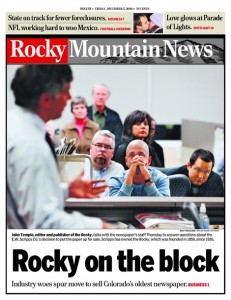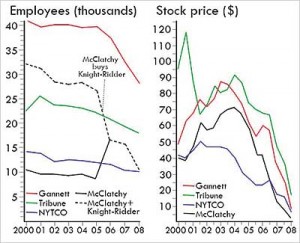 We’re anticipating that the R.I.P. column to the left could get quite a bit longer in 2009, and it’ll probably start with the Rocky Mountain News. The venerable Denver newspaper (at 149 years, it is said to be the longest-running business in Colorado) was put up for sale last week by E W Scripps. No one, however, thinks Scripps will find a buyer. If so, the Rocky will close around mid-January.
We’re anticipating that the R.I.P. column to the left could get quite a bit longer in 2009, and it’ll probably start with the Rocky Mountain News. The venerable Denver newspaper (at 149 years, it is said to be the longest-running business in Colorado) was put up for sale last week by E W Scripps. No one, however, thinks Scripps will find a buyer. If so, the Rocky will close around mid-January.
Buyers won’t surface because, as Wayne State University’s Ben Burns says in a colorful quote in the rival Denver Post, it would be like “buying an anchor that’s already been thrown overboard.”
Except it would be more like being chained to that anchor. The Rocky is on track to lose $11 million this year and no one is forecasting a revival of the advertising market until at least the third quarter of 2009. Any buyer would also assume a 50% share in the Denver Newspaper Agency, a joint venture set up in 2001 to operate both the Rocky and the Post in such a way that both papers can survive. The Agency is now losing money and its governance structure makes it difficult for any buyer to make changes without going through approvals and competitive disclosures.
The most likely buyer would be the Post, but quotes by Publisher Dean Singleton last week left little doubt about that possibility: “We wish Scripps well as it leaves the Denver newspaper market,” wrote Singleton in a letter to employees. Why would Singleton want to buy the Rocky, anyway? It’s cheaper and easier to let the paper fail and then pick up whatever assets and people the Post needs to fill in the gaps. There would also be less likelihood of an antitrust challenge under that scenario.
The Rocky employs 220 people in the newsroom, all of whom will lose their jobs if the paper fails. The paper has a rich journalistic tradition, including two Pulitzer Prizes as recently as 2006. People aren’t exactly dancing in the streets at the Post, however. As columnist William Porter notes, “I feel like I did upon hearing an old adversary was terminally ill: bad for him and bad for myself, because in butting heads we somehow made each other better.”
It seems oddy fitting, by the way, that one of the Rocky‘s recent Pulitzers was for a photo essay called “The Final Salute.” As of this morning, there are nearly 300 comments on the story on the Rocky website about the sale.
Politico Reports Strong Response to New Wire Service
Attempting to exploit newspapers’ frustration with the Associated Press, CNN has stepped into the breach with its own international news network. But the cable company may face some unexpected competition: The Politico. The Washington-based boutique news service, which specializes in Capitol Hill coverage, has signed up 67 newspapers for its news service over the last three months. They include the Arizona Republic, Des Moines Register, Atlanta Journal-Constitution and Philadelphia Inquirer, as well as all 27 dailies owned by Advance Publications. Several of its new clients are in dire financial circumstances and have cut back upon or eliminated their Washington bureaus. That makes Politico’s value proposition compelling. As we’re written before, The Politico continues to be an example of how specialized journalism can fill the gap left by broad-based media titans in an era of micro markets.
Miscellany
- Newsday will slash 100 jobs, or about 5% of its workforce, in its third headcount reduction of the year. According to a report on Newsday.com, “In the newsroom, the photo operation would be restructured with 20 photographers told to reapply for new positions. Also impacted would be three sports columnists and a reporter-researcher in the Albany bureau.” Most open positions will also be eliminated. Newsday has cut 250 jobs this year, or about 9% of its staff.
 MediaPost’s Media Daily News runs the summary numbers and they’re ugly (right). Gannett has cut headcount from 41,000 in 2000 to about 29,000 today. Tribune Co. is down 30% to 18,000 people. The New York Times Co.’s workforce is about 26% smaller than it was in 2000. McClatchy has reduced its workforce by more than the number of employees it picked up with the acquisition of Knight-Ridder in 2006. In all, the big newspaper publishers have cut more than 25% of their staff in the last eight years, and there are few spots on the horizon that indicate that employment might come back. By the way, Erica Smith’s Paper Cuts layoff tracker puts total 2008 US newspaper layoffs and buyouts at 15,153 and counting.
MediaPost’s Media Daily News runs the summary numbers and they’re ugly (right). Gannett has cut headcount from 41,000 in 2000 to about 29,000 today. Tribune Co. is down 30% to 18,000 people. The New York Times Co.’s workforce is about 26% smaller than it was in 2000. McClatchy has reduced its workforce by more than the number of employees it picked up with the acquisition of Knight-Ridder in 2006. In all, the big newspaper publishers have cut more than 25% of their staff in the last eight years, and there are few spots on the horizon that indicate that employment might come back. By the way, Erica Smith’s Paper Cuts layoff tracker puts total 2008 US newspaper layoffs and buyouts at 15,153 and counting.- A dozen Baltimore Sun employees have left the company and three were laid off in the first announced job reductions since the paper’s 100-employee blood bath in August.
Comments
This entry was posted on Monday, December 8th, 2008 at 9:13 am and is filed under Facebook, Hyper-local. You can follow any responses to this entry through the RSS 2.0 feed. Both comments and pings are currently closed.



[…] this link: Newspaper Death Watch ▶ Comment /* 0) { jQuery(‘#comments’).show(”, change_location()); jQuery(‘#showcomments […]